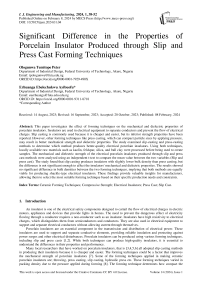Significant Difference in the Properties of Porcelain Insulator Produced through Slip and Press Cast Forming Techniques
Автор: Ologunwa Temitope Peter, Erhuanga Ebelechukwu Ayibuofu
Журнал: International Journal of Engineering and Manufacturing @ijem
Статья в выпуске: 1 vol.14, 2024 года.
Бесплатный доступ
This paper investigates the effect of forming techniques on the mechanical and dielectric properties of porcelain insulators. Insulators are used in electrical equipment to separate conductors and prevent the flow of electrical charges. Slip casting is commonly used because it is cheaper and easier, but its inferior strength properties have been reported. However, other forming techniques like press casting, which can compact particle sizes by applying pressure, may result in better mechanical strength and dielectric properties. The study examined slip-casting and press-casting methods to determine which method produces better-quality electrical porcelain insulators. Using both techniques, locally available raw materials such as kaolin, feldspar, silica, and ball clay were processed before being used to create samples. The mechanical and dielectric strength of the electrical porcelain insulators produced through slip and press cast methods were analyzed using an independent t-test to compare the mean value between the two variables (Slip and press cast). The study found that slip casting produces insulators with slightly lower bulk density than press casting, but the difference is not significant enough to affect the insulators' mechanical and dielectric properties. The results showed no significant difference in bulk densities between the two forming techniques, implying that both methods are equally viable for producing shackle-type electrical insulators. These findings provide valuable insights for manufacturers, allowing them to select the most suitable forming technique based on their specific production needs and constraints.
Ceramic forming techniques, compressive strength, electrical insulators, press cast, slip cast
Короткий адрес: https://sciup.org/15018839
IDR: 15018839 | DOI: 10.5815/ijem.2024.01.04
Список литературы Significant Difference in the Properties of Porcelain Insulator Produced through Slip and Press Cast Forming Techniques
- U. Ekpunobi, C, Ihueze, P., Igbokwe, A.., Ekpunobi, H., Obiora-Ilouno, C., Onu, … E. Amalu, Production of Electrical Porcelain Insulators from Local Raw Materials: A Review. 2021. IntechOpen. doi: 10.5772/intechopen.
- C. S. Ekenyem, C. I. Adindu, F. A. Oduagwu, and N. P. Nwabuna. Assessing the Suitability of Selected Nigerian Local Clays for the Production of Electrical Porcelain Insulator. School of Engineering Technology (SET) 2016 Engineering and Technology Conference and Exhibition, Akanu Ibiam Federal Polytechnic, Unwana, Ebonyi State, Nigeria, 14-17 June 2016.
- I. B. Kashim, Sustainable and Economic Survey of Local Ceramic Raw Materials for Production of Porcelain Bodies in Nigeria. A PhD Thesis (2004). Presented in the Department of Industrial Design, Federal University of Technology, Akure. (Unpublished).
- L. U Anih, Indigenous Manufacture and Characterization of Electrical Porcelain Insulators. Nigeria Journal of Technology. 24(1); 1-7. 2005.
- C. C Okolo, O.A, Ezechukwu, C.O, Olisakwe, C.E, Ezendokwelu, and C. Umunna. Characterization of Electrical Porcelain Insulators from Local Clays. International Journal of Research-GRANTHAALAYAH. 3(1): 26-36. 2015.
- A. O. Oladiji, J.O, Borode, Adewuyi and I.O. Ohijeagbon, (2010). Development of Porcelain Insulators from Locally Sourced Materials. USEP. Journal of Research Information in Civil Engineering. 7(1): 47-57. 2010.
- J. Kluss, M. R, Chalaki, W., Whittington, H., Rhee, S., Whittington, A, Yadollahi. Porcelain insulation – defining the underlying mechanism of failure. High Voltage, Volume 4, Issue 2, June 2019: Pages 81-88. https://doi.org/10.1049/hve.2019.0004.
- G. M. Moses and E. Park, “Ceramic Raw Materials in Tanzania – Structure and Properties for Electrical Insulation Application,” International Journal of Engineering Research & Technology (IJERT), vol. 3, no. 10, 2014.
- College of Engineering, Design, Art and Technology (CEDAT). Development of an appropriate Technology for Production of Electric Porcelain Insulators from Ceramic Minerals in Uganda. 2012. Press Release, Makerere University. http://www.cedat.mak.ac.ug
- P. W. Olupot. Assessment of Ceramic Raw Materials in Uganda for Electrical Porcelain. (2006). Licentiate of Materials Science and Engineering, Royal Institute of Technology (KTH), Stockholm, Sweden.
- B. A. Merga, H. C. A. Murthy, E. Amare, K. Ahmed, and E. Bekele, “Fabrication of electrical porcelain insulator from ceramic raw materials of Oromia region, Ethiopia,” Heliyon, vol. 5, no. 8, p. e02327, Aug. 2019, doi: 10.1016/j.heliyon.2019.e02327.
- Kyasager, Siddaraju, & Prasanna. Development of Optimum Slip Ratio for High Voltage Porcelain Insulator Manufacturing. International research journal of engineering and technology (IRJET). 2016, 3(2): 522-527.
- M. K. Onwughalu, C. M. Ogwata. Enhancement of Ceramic Insulator Properties with Periwinkle Shell as An Additive. Iconic Research and Engineering Journals. 2019. 3(1), 118-121.
- M. G. Moyo & E. Park. Ceramic Raw Materials in Tanzania – Structure and Properties for Electrical Insulation Application. International Journal of Engineering Research & Technology (IJERT). October- 2014. Vol. 3 Issue 10, 1015-1020
- N. S. Mehta, P. K. Sahu, P. Tripathi, R. Pyare, M. R. Majhi. Influence of alumina and silica addition on the physico-mechanical and dielectric behavior of ceramic porcelain insulator at high sintering temperature. Boletín de la Sociedad Española de Cerámica y Vidrio, Vol 57, Issue 4, 2018, Pages 151-159. https://doi.org/10.1016/j.bsecv.2017.11.002.
- V.C. Nwachukwu and S.A. Lawal. Investigating the Production Quality of Electrical Porcelain Insulators from Local Materials. IOP Conf. Series: Materials Science and Engineering 413 (2018) 012076 doi:10.1088/1757-899X/413/1/012076
- U. E. Ekpunobi, U. A. Onuigbo, I. Tabugbo, E. Amalu, C. Ihueze, C. Onu, P. Igbokwe, A. Ekpunobi, S. Agbo and H. Obiora-Ilouno. The investigation of the physical properties of an electrical porcelain insulator manufactured from locally sourced materials. Physical Sciences Reviews, 2023. https://doi.org/10.1515/psr-2022-0236
- D. F. Atanda, O. O. Oluwole, T. A. Oladeji. Electrical Porcelain Production from Selected Kaolin Deposit in South Western Nigeria Using Slip Casting. International Journal of Materials and Chemistry. 2012. 2(3): 86-89 DOI: 10.5923/j.ijmc.20120203.01
- C. Onuoha, J.E.O. Ovri and U. Mark. Characterization of Ibere Clay for the Production of Electrical Porcelain Pin Insulators. Int’l Research Journal in Engineering, Science and Technology (IREJEST), Vol. 11, No. 1 (2014), pp. 47–55.
- S. Kasrani, A. Harabi, S.-E. Barama, L. Foughali, M. T. Benhassine, and D. M. Aldhayan, “Sintering and dielectric properties of a technical porcelain prepared from economical natural raw materials,” Cerâmica, vol. 62, no. 364, pp. 405–412, Dec. 2016, doi: 10.1590/0366-69132016623641994.


